What is the impact of cinema advertising compared to other channels?
Veröffentlicht AM 06 05 2024The film business has exploded in growth. Post-pandemic, a lot of people went back to the movies, and attendance records are being shattered globally. In addition, this generates extra advertising opportunities in movie theatres.
After the pandemic, the film industry is booming again. Many moviegoers have returned to the theatres, and box office records have been broken around the world. More people are therefore now exposed to movie-theatre advertising again.
How do movie lovers perceive such advertising and how does it compare to other advertising channels such as TV, online video, and social advertising? How can you create memorable cinema commercials with the right impact on brand and message recall? And what movie ad performs the best in DVJ’s long-running cinema benchmark?
These and other questions are addressed in this article based on a large number of pre-tests of 150 cinema commercials conducted in collaboration with Jean Mineur Mediavision, the largest Dutch cinema advertising operator.
GEN-Z FINDS IT’S WAY TO THE MOVIE THEATERS BEST
People of all ages returned to movie theatres with a noticeable increase in reach over the last year. Yet, Gen-Z actually outperformed all other generations in terms of visits in the previous year, with reach among this group (aged 16 to 23) almost doubling between 2021 and 2022!
Figure 1: Reach of Dutch movie theatres by age

PRE-TESTING TO PREDICT AND IMPROVE IMPACT
The cinema pre-testing database, based on the long-term cooperation between DVJ Insights and Jean Mineur Mediavision, consists of more than 150 cinema advertisements from global brands like Samsung, Heineken, Rituals, Phillips, Unilever, McDonald’s, ALDI, and IKEA that were tested among over 21,000 moviegoers.
With a high in-market predictive value, DVJ’s Ad Reality pre-test uses a variety of implicit and explicit research techniques to assess the effects of a cinema commercial following natural in-context exposure, taking into account how consumers engage with the medium and advertising.
Figure 2: A selection of global and local brands included in the database by DVJ Insights in collaboration with Jean Mineur Mediavision
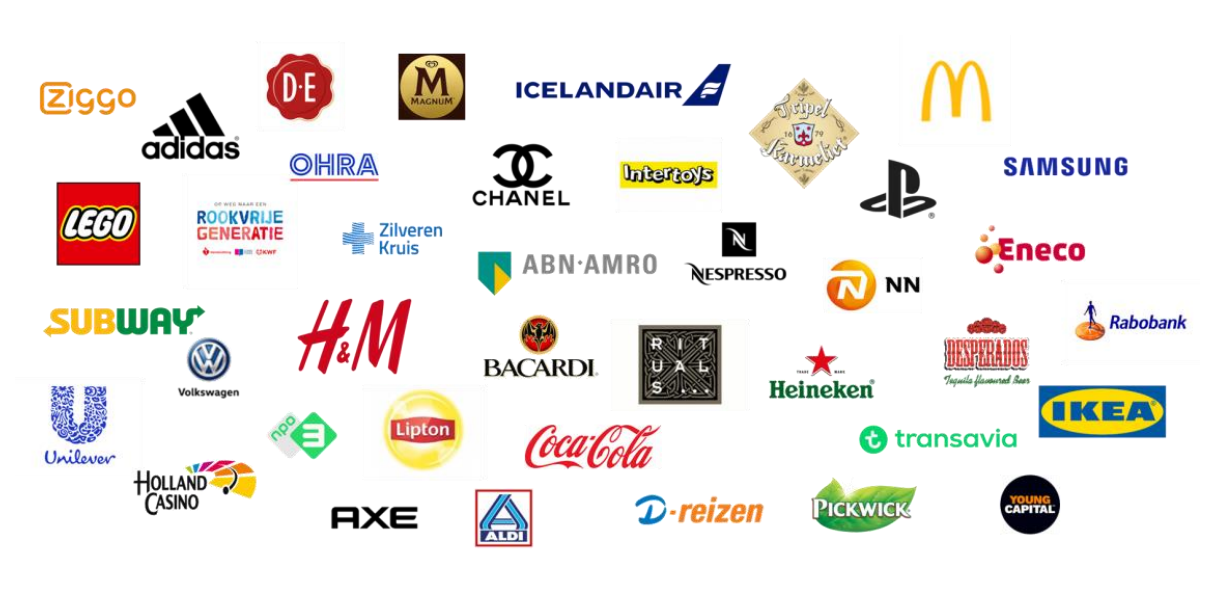
Pre-testing cinema advertisements provide information about the ads‘ performance in terms of brand and message recall, whether they can develop positive and distinctive associations, how they are evaluated on different aspects (such as brand fit, relevance, credibility, activation) as well as on a moment-to-moment scenes perspective. Other insights provided are buying intention, the degree to which people are willing to share their own experience, which moment-to-moment scenes viewers respond more or less favourably to, and whether the ad can activate the brand in consumers‘ minds.
All these insights can be used to understand and improve the performance of (cinema) advertising and even predict in-market success based on all information in DVJ’s comprehensive benchmark. Additionally, we can compare the impact of cinema advertising with other media such as TV, online video, and social advertising, in a broad sense as well as specifically on Gen-Z (as their attention is more challenging to capture).
AD AVOIDANCE IN EUROPE
Before discussing the effectiveness of cinema in comparison to other channels, it’s important to be aware that consumer attitudes are generally negative towards advertising. In the Netherlands, advertising is presented with a particularly difficult challenge since 87% of people simply do not like commercials. As shown in the figure, dramatically, Gen-Z is even less positive about advertising compared to Millenials and Gen-X.
Figure 3: Attitude toward the advertising, country, and generational comparison
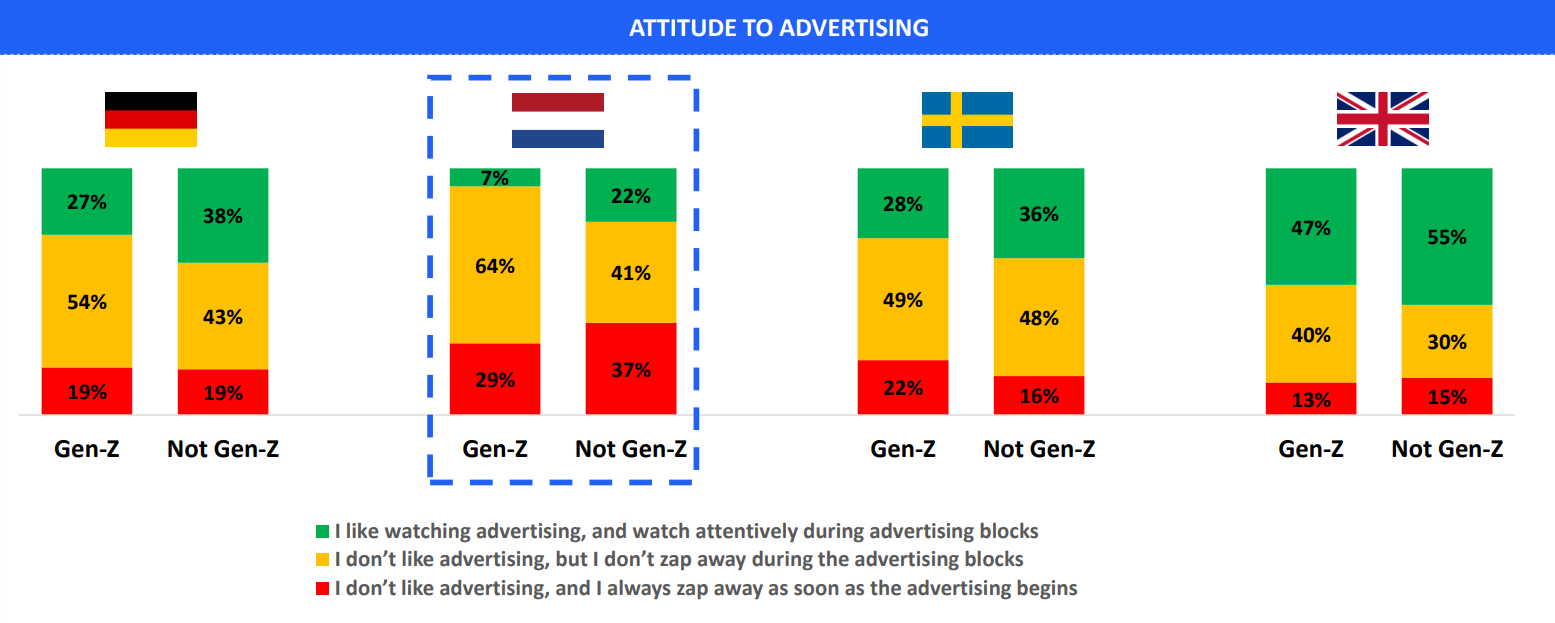
For some marketers, being passionate about telling their stories, this negative attitude is still surprising, while it leads to less attention and in turn less impact than desired. Furthermore, we know that Gen-Z shows much worse brand recall (after being exposed to advertising) than those over 35 years of age (source: DVJ Insights‘ pre-testing database across different advertising channels), making this a particularly challenging group.
Brand recall is considered an important KPI, and it is thus reliant on attention, which is dependent on the platform. For example, TV ads are zapped away most often within 10 seconds, printed ads are scanned in less than 2 seconds, social media ads have an average in-view time of only 1.8 seconds, and skippable online videos often being clicked away as soon as possible. In sum, gaining attention for your advertisement is crucial for brand and message recall, this is even more challenging for Gen-Z and it depends on the creative execution and the media channel.
CREATIVE QUALITY IMPORTANT DRIVER FOR SUCCESS
The effectiveness of a campaign, in Mark Ritson’s opinion, depends on creative development, outpacing synergies of multimedia effects and budget setting. In fact, with limited budgets, your creatives need to stand out so you can allow yourself to spend less on media and still achieve the same effectiveness, says Caroline van Turennout – Director of Marketing & E-commerce at Zeeman in a Brand Growth interview with DVJ Insights.
The importance of creative quality cannot be overstated. Iterative pre-testing of all relevant campaign assets guarantees improved creative quality for all markets and channels (by transforming an average ad into a top 20% performer). It also serves a multiplier effect of creative quality on campaign efficiency with an (actual) 600 GRP campaign being worth 100 GRPs more in terms of effectiveness, on average.
HOW EFFECTIVE ARE CINEMA COMMERCIALS COMPARED TO OTHER CHANNELS?
It may appear that capturing the attention of moviegoers is an easy task because they are fully exposed (and relaxed) right before the film begins, but if your ad is not perceived positively and does not yield an impact, it won’t be effective.
So what happens next? Cinema surpasses advertising on television, online video, and social media (social advertising taken as an index 100) in the DVJ Insights cross-channel pre-testing database in terms of positive and distinctive associations (index of 139 and 138, respectively) evoked by the ad, as well as viewer´s enjoyment (index of 112).
Figure 4: Performance of advertising on different channels and its effect on brand recall
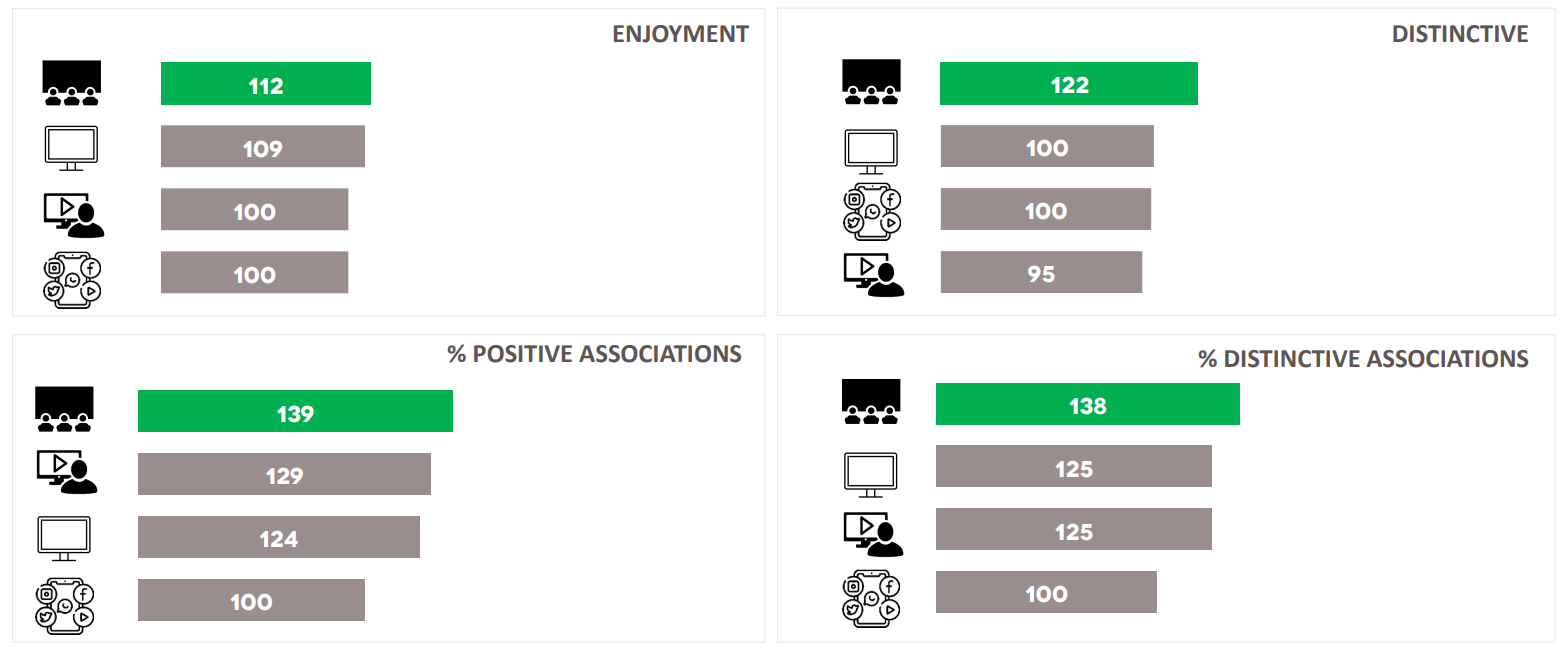
Even though brand building is often the goal, cinema advertising also performs well in terms of activation, scoring the same on purchase intent as social (index 100) and significantly better than television (index 62)!
Figure 5: Performance of advertising on different channels and its effect on activation
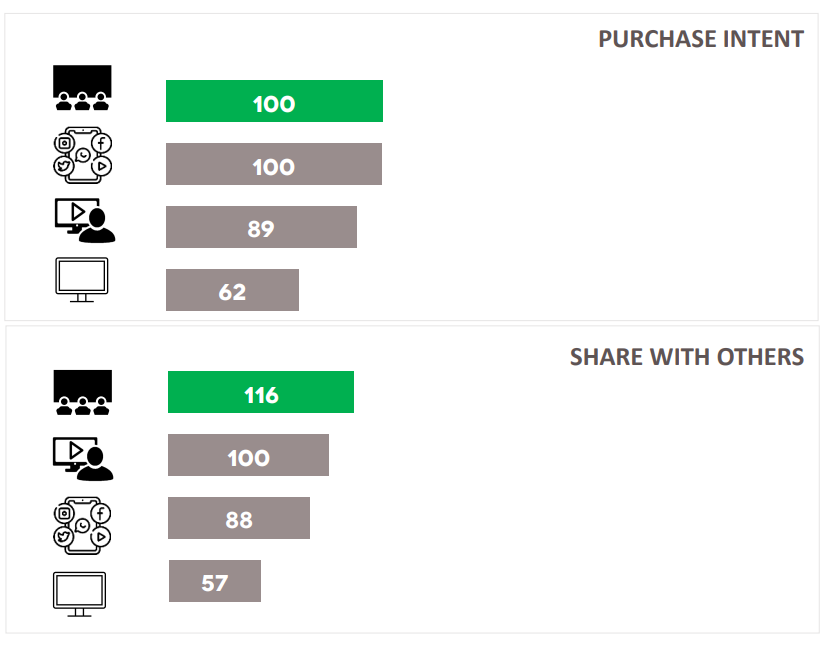
Yet, what about brand impact? A meta-analysis found that the brand impact dimensions are the most important predictors of in-market effect, and unaided brand recall and claimed message recall in particular. These are thus the most important KPIs and should in principle always be maximised, i.e. aim for the top 20% for an ad to be especially effective. Interestingly, cinema as a channel outperforms here as you can see in the figure below.
Figure 6: Performance of advertising on different channels and its effect on brand impact
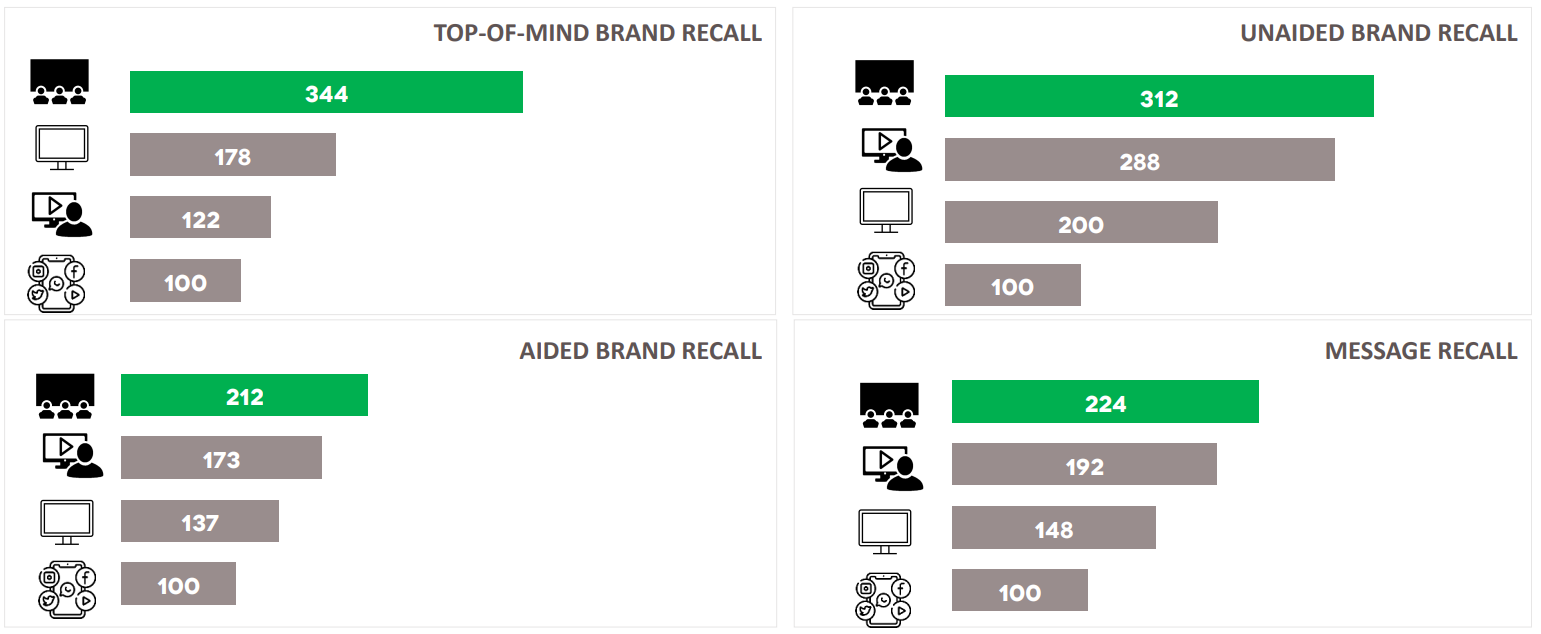
CONNECTING WITH GEN-Z THROUGH CINEMA ADVERTISING
Gen-Z, as an even more demanding audience, rates cinema ads lower on distinctiveness, excitement, and enjoyment than non-Gen-Z viewers. On the other hand, both groups exhibit high levels of brand impact and association build-up, highlighting overall effectiveness. This makes cinema a unique channel to effectively reach Gen-Z consumers, as we don’t see it „underperforming“ among this age group as we see for channels such as TV.
Figure 7: The effects of cinema advertising on brands & associations across generations
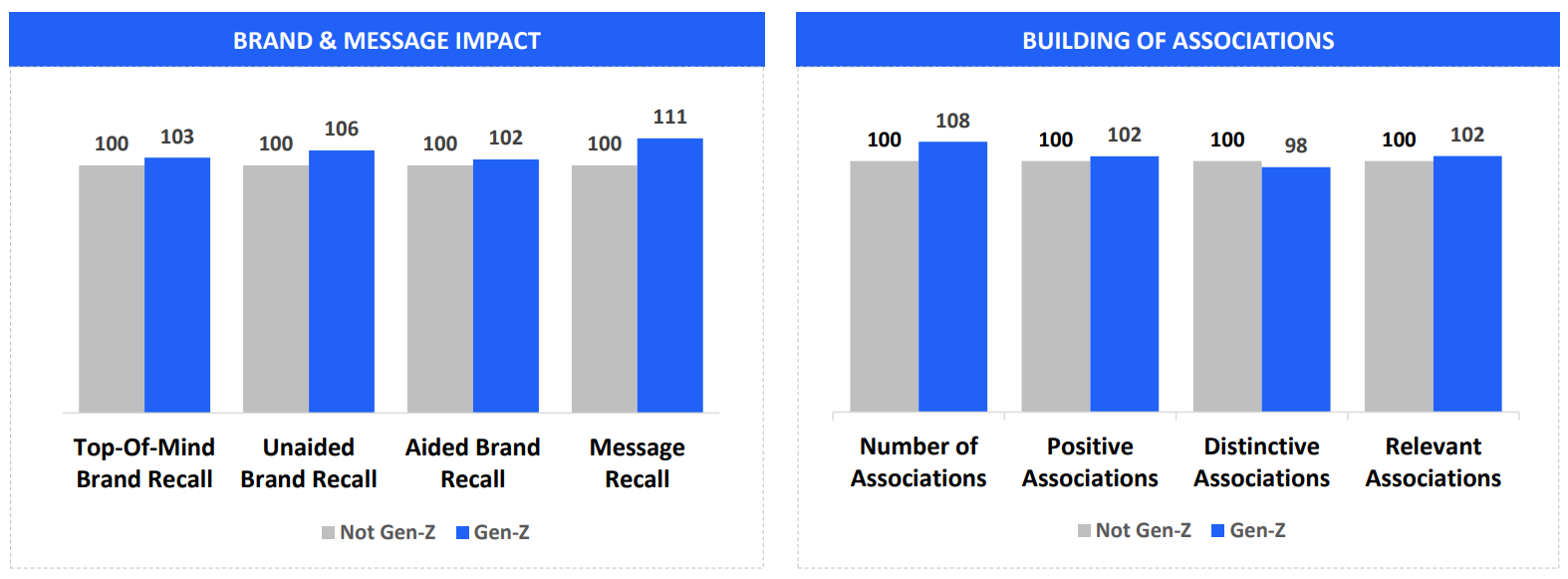
STILL THE BEST-PERFORMING AD: THE SUMMER IS ABOUT SHARING
What cinema ad performs the best in DVJ’s long-running cinema benchmark of around 150 advertisements?
McDonald’s 2023 summer campaign “Summer is for sharing” still stands out clearly above the cinema benchmark.
The commercial video centres on Marit, a Texel girl who, alongside her father, offers day trips aboard a fishing boat. There, she meets Lotte, a city girl, to whom she exhibits all of Texel’s beauty. Comforts that none of you have on the mainland. But Lotte finally succeeds in surprising her with an item not found on the island.
Figure 8: Snippet of McDonald´s successful commercial

The commercial video centres on Marit, a Texel girl who, alongside her father, offers day trips aboard a fishing boat that has been modified. There, she meets Lotte, a city girl, to whom she exhibits all of Texel’s beauty. Comforts that none of you have on the mainland. But Lotte finally succeeds in surprising her with an item not found on the island. The advertisement scores above the cinema benchmark consisting of 150 ads in terms of brand recall (both aided and unaided), clarity of the message, and brand impact.
Furthermore, with 69% positive and distinct associations it also outperforms DVJ’s benchmark. This is, as expressed in the open-ended answers, “A feel-good story showing the value of sharing McDonald’s with your loved ones.“ and “ It’s all about connection with others, which McDonald’s can help you with.” Why do people find this commercial appealing? Some of the responses reveal: “Nice storyline of the girls running into each other is well thought out“ or “The feeling that it is love and is shared.“
Quite the task for McDonald’s and other movie theatre marketing to top this!